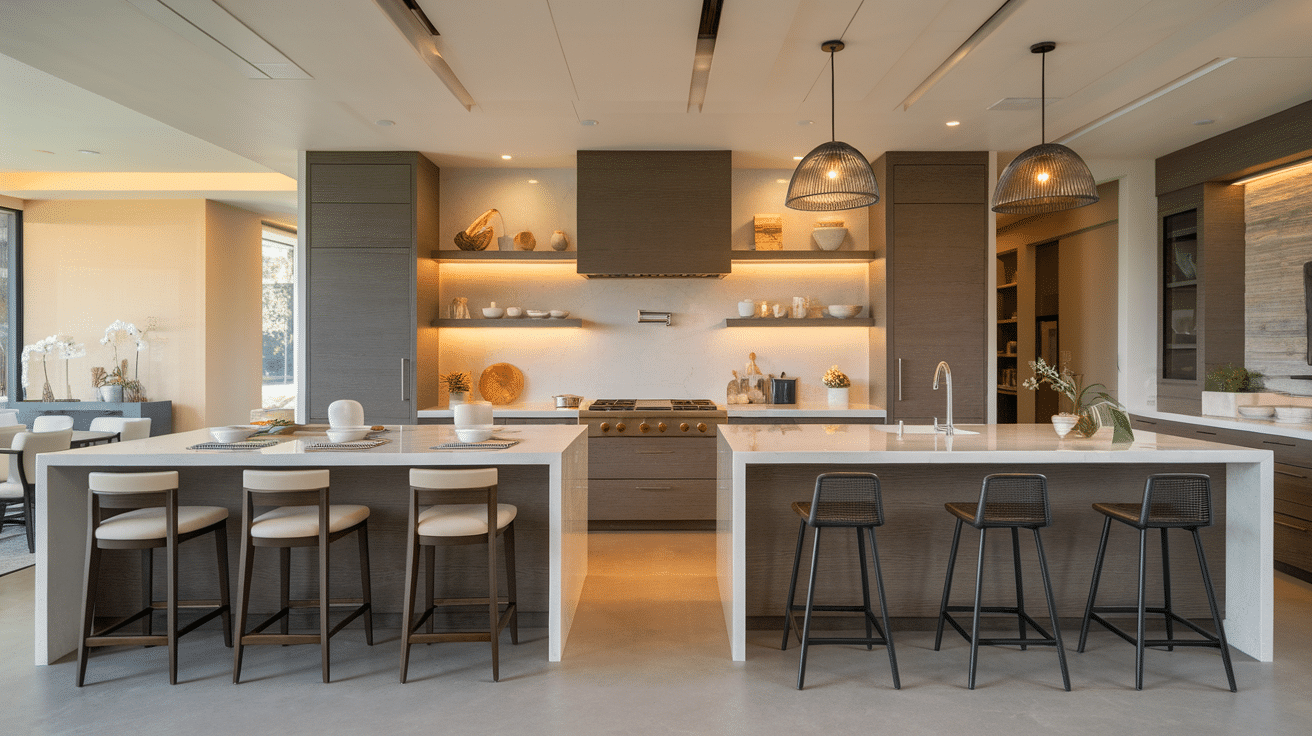One of the most debated decisions regarding kitchen island countertops is whether to choose counter-height or bar-height surfaces.
Counter-height islands are 34-36 inches from the floor, while bar-height islands sit higher at 40-42 inches. Both options have unique advantages, and your choice depends on your layout and how you plan to use your island.
This decision affects not only the visual appeal of your kitchen but also its functionality, comfort, and accessibility for family members of all ages.
The height you choose will determine what type of seating works best and how the island integrates with your existing kitchen design.
This guide will help you understand the differences and make an informed decision for your kitchen.
Understanding Kitchen Island Heights
The height of a kitchen island affects everything from daily comfort to long-term usability. Understanding standard measurements helps you make an informed choice that effectively serves your family’s needs.
What is Counter Height?
Counter-height islands measure 34-36 inches from the floor and represent the industry standard for kitchen islands.
The consistent height matches existing kitchen counters, creating a cohesive look that flows naturally throughout your workspace.
What is Bar Height?
Bar-height counters, measuring 40-42 inches high, create a raised area perfect for socializing, casual dining, and entertaining guests.
The additional height creates a more formal dining experience and encourages social interaction by bringing seated guests closer to eye level with standing family members.
Counter Height vs Bar Height: Key Differences
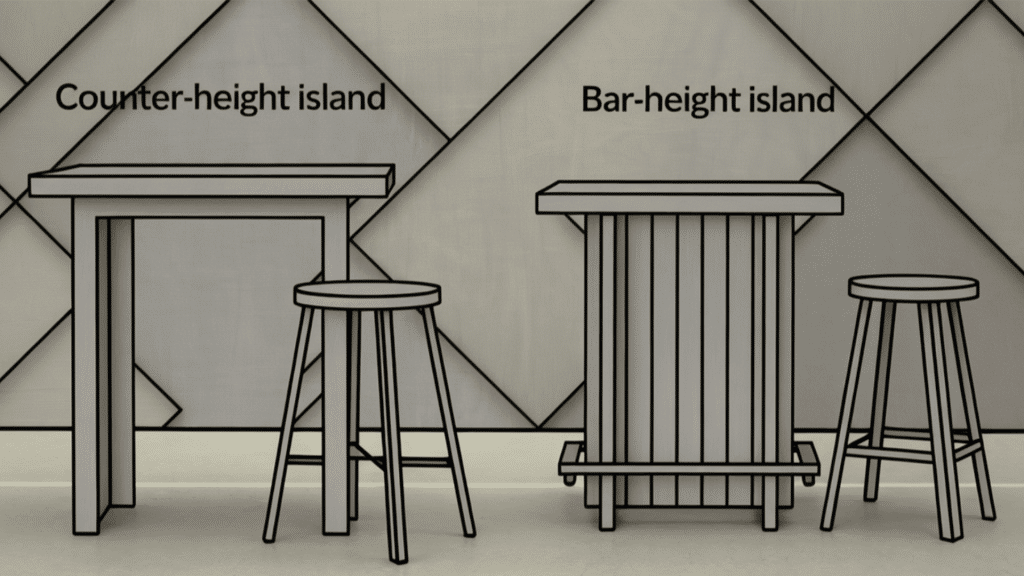
Understanding the specific differences between these two options helps you evaluate which works best for your kitchen layout and family lifestyle.
Counter-height islands prioritize accessibility and versatility, making them ideal for families with mixed age groups and those who value smooth workspace integration.
Consider your kitchen’s existing elements, ceiling height, and how the island will integrate with surrounding countertops and cabinetry.
The right choice should complement your cooking habits, entertaining style, and long-term family needs.
| Feature | Counter Height | Bar Height |
|---|---|---|
| Surface Height | 34-36 inches | 40-42 inches |
| Stool Height | 24-27 inches | 28-33 inches |
| Legroom | 10-12 inches | 10-12 inches |
| Primary Use | Food prep, casual dining | Entertaining, socializing |
| Accessibility | Easy for all ages | Challenging for children/elderly |
| Visual Impact | Opens up space | Creates a focal point |
| Storage | Standard cabinet height | Additional vertical storage |
Counter-Height Kitchen Islands
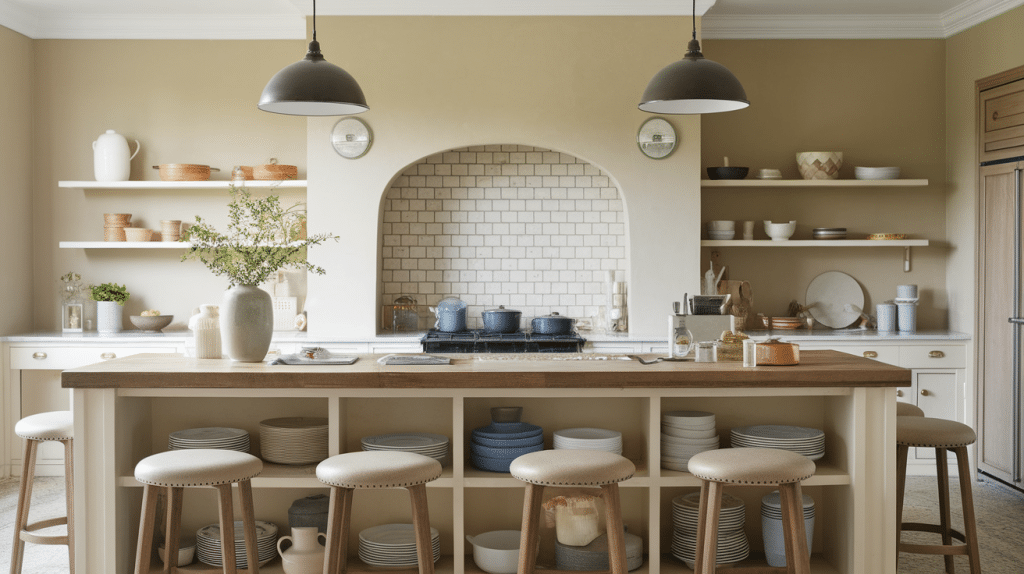
Counter-height islands serve as the foundation of most kitchen designs, offering practicality and versatility for daily use.
These islands work particularly well in kitchens where functionality and accessibility take priority over formal entertaining spaces.
Stool Requirements
| Feature | Counter-Height Stools | Benefits |
|---|---|---|
| Seat Height | 24-27 inches from the floor | Provides comfortable seating with proper legroom clearance |
| Accessibility | Lower seat height | Makes it easier for users to get in and out of seats, particularly important for children and elderly family members |
| Back Support | Recommended for extended use | Adds comfort during longer sitting periods |
| Swivel Feature | Helpful addition | Assists with easy entry and exit from the seating |
| Footrests | Additional comfort feature | Provides extra comfort for users of varying heights |
Advantages of Counter-Height Islands
Comfortable for average users: Provides an ideal working height for food preparation, eliminating strain during extended cooking sessions.
Family-friendly: Easy access for children and elderly family members makes it perfect for multi-generational households.
Opens up space: Creates an open, airy feel that makes kitchens appear larger and more spacious.
Multi-functional: Works perfectly for breakfast, homework, family gatherings, and everyday activities without requiring different seating arrangements.
Disadvantages of Counter-Height Islands
Less comfortable for tall individuals: Users over 6 feet tall may find the height too low, leading to hunching and back strain during food preparation.
Limited storage: Offers less vertical storage space underneath compared to bar-height alternatives.
No clutter hiding: Everything remains visible at eye level, making it difficult for guests to hide kitchen clutter.
Bar-Height Kitchen Islands
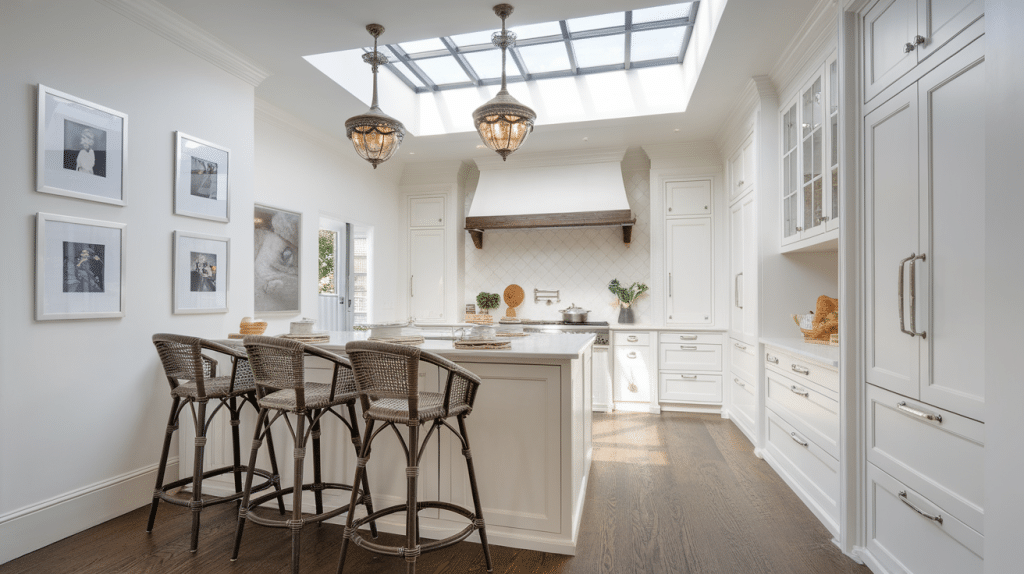
Bar-height islands create a distinct social area while adding visual dimension to your kitchen space. These islands work particularly well in open-concept homes where the kitchen connects to living and dining areas.
Stool Requirements
| Feature | Bar-Height Stools | Benefits |
|---|---|---|
| Seat Height | 28-33 inches from the floor | Maintains the exact 10-12 inches of legroom as counter-height seating |
| Construction | A more substantial build is required | Increased height requires proper support and stability features |
| Sturdiness | Sturdy construction with appropriate weight ratings | Ensures safety and durability for elevated seating |
| Adjustability | Many include adjustable features | Accommodates users of different heights, making it more versatile for various family members |
Advantages of Bar-Height Islands
Great for socializing: Creates a cozy social space with elevated seating that brings guests closer to eye level with standing hosts.
Hides kitchen clutter: The raised ledge provides a visual barrier, effectively hiding food preparation mess from guests in adjacent rooms.
Comfortable for tall people: Offers better ergonomics for taller users, reducing the need to bend over while working at the counter.
Disadvantages of Bar-Height Islands
Less accessible: Higher seating poses challenges for children and elderly users who may struggle to safely climb onto tall stools.
Takes up visual space: Can make kitchens appear smaller and more cramped, particularly in rooms with lower ceilings or limited square footage.
Higher cost: Requires additional materials and labor for construction, resulting in increased installation expenses compared to standard counter-height options.
What Most People Prefer: Counter-Height Islands
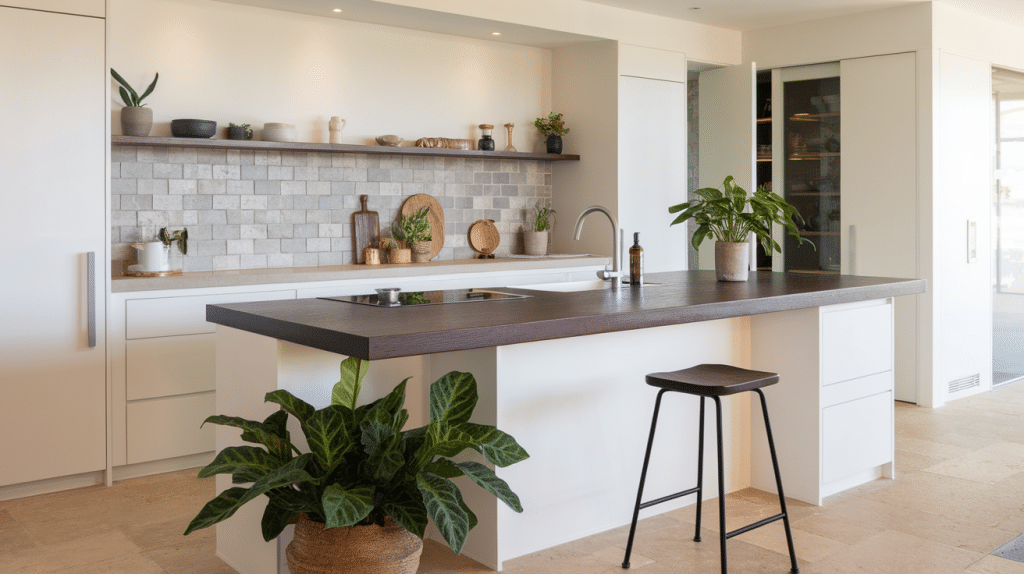
Most homeowners opt for counter-height islands due to their functionality, comfort, and aesthetic appeal. Research shows that counter-height islands consistently rank higher in homeowner satisfaction surveys and real estate preferences.
- Comfort and accessibility: Suits people of all ages and mobility levels, promoting frequent use and family interaction.
- Unified workspace: Provides continuous work surfaces that integrate seamlessly with existing kitchen counters for efficient meal preparation.
- Clean appearance: Single-level counters create a clean, uncluttered look that contributes to a more organized and spacious appearance.
- Social interaction: Facilitates easier interaction between sitting and standing family members, promoting conversation during daily activities.
While bar-height islands have their advantages, counter-height options consistently win for overall versatility and accessibility across different household types and lifestyles.
Kitchen Island Height: Making the Right Choice
Selecting the appropriate kitchen island height requires careful consideration of your family’s specific needs, kitchen layout, and long-term usage patterns. The right choice will serve your household well for many years.
1. Consider Your Family’s Needs
Smaller kitchens, households with children, and elderly family members benefit most from counter-height islands due to their practicality and accessibility.
Consider the physical capabilities of all household members who will use the island regularly, as counter-height islands accommodate the broadest range of users comfortably and safely.
2. Evaluate Your Space
Larger kitchens can accommodate bar-height islands more easily, while smaller spaces may feel cramped with the additional visual weight.
Open-concept floor plans often benefit from bar-height islands that create natural separation between kitchen and living areas, but ensure the height doesn’t block essential sight lines or make the space feel divided.
3. Think About Usage Patterns
If you frequently entertain or want to separate kitchen activities from social areas, bar-height islands create distinct zones while hiding kitchen clutter.
For families who use their kitchen island primarily for daily meals, homework, and food preparation, counter-height islands typically provide better functionality and comfort.
4. Dual-Height Option
Some kitchens feature dual-height islands that combine counter-height workspace with bar-height seating areas, offering the best of both worlds for families who can’t decide between options.
Dual-height islands require more space and budget but can solve the dilemma for households with diverse needs and preferences.
Which One Is Right for You?
Choosing between counter-height and bar-height for your kitchen island height depends on finding the right balance between functionality, style, and comfort.
Bar-height islands work best for entertainment-focused kitchens and homes with adult-only households or specific design requirements.
They create distinct social zones, provide additional storage, and offer visual separation between kitchen and living areas.
The right choice will support your family’s daily routines while providing years of functional and aesthetic satisfaction.
Share your thoughts in the comments below! Your insights could help other homeowners make the best choice for their kitchen renovation.

